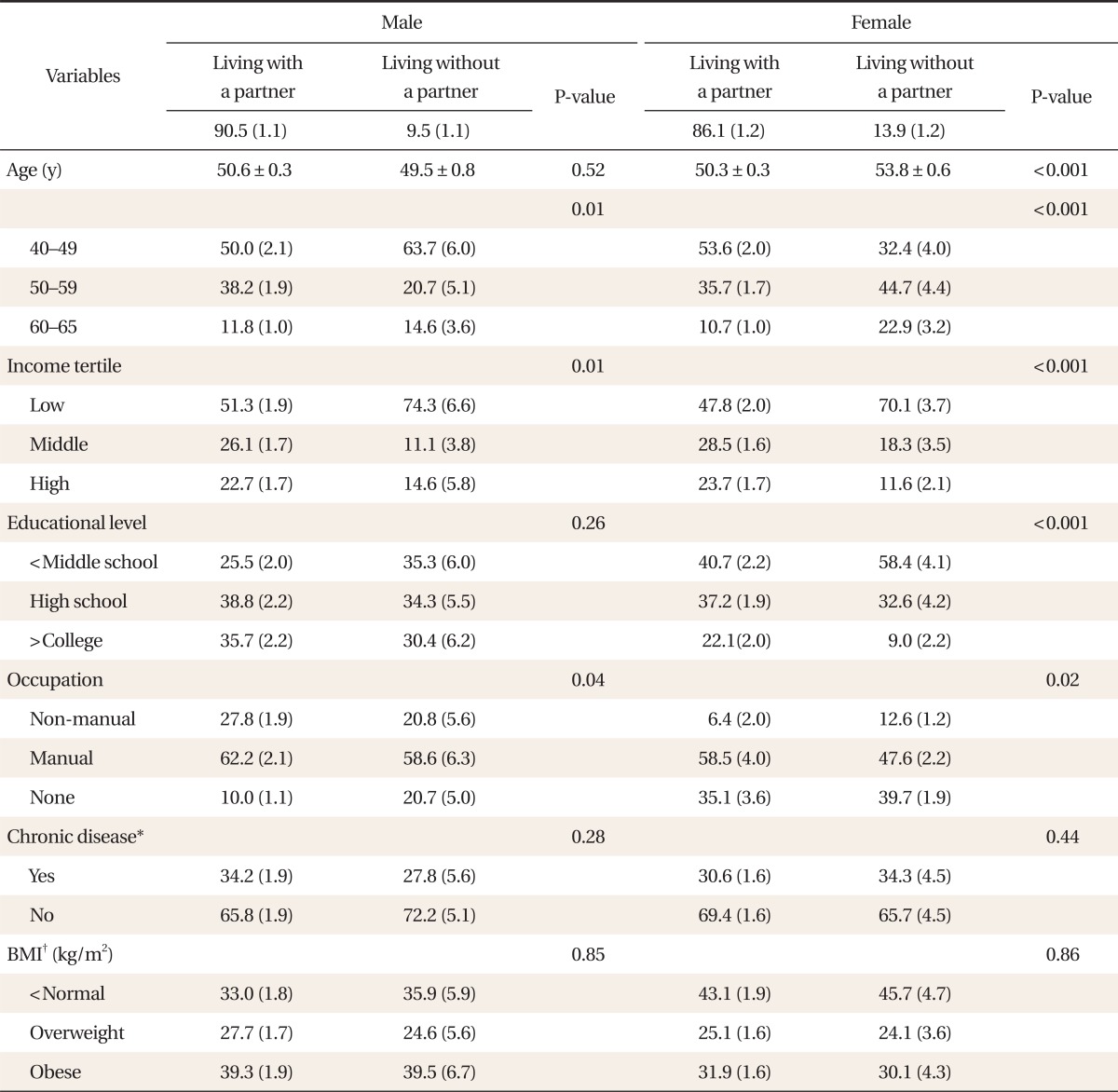1. Manzoli L, Villari P, M Pirone G, Boccia A. Marital status and mortality in the elderly: a systematic review and metaanalysis. Soc Sci Med 2007;64:77-94. PMID:
17011690.


2. Schoenborn CA. Marital status and health: United States, 1999-2002. Adv Data 2004;(351):1-32. PMID:
15633583.

3. Ben-Shlomo Y, Smith GD, Shipley M, Marmot MG. Magnitude and causes of mortality differences between married and unmarried men. J Epidemiol Community Health 1993;47:200-205. PMID:
8350032.



4. Lee S, Cho E, Grodstein F, Kawachi I, Hu FB, Colditz GA. Effects of marital transitions on changes in dietary and other health behaviours in US women. Int J Epidemiol 2005;34:69-78. PMID:
15231759.


5. Osler M, McGue M, Lund R, Christensen K. Marital status and twins' health and behavior: an analysis of middle-aged Danish twins. Psychosom Med 2008;70:482-487. PMID:
18480194.



6. Eng PM, Kawachi I, Fitzmaurice G, Rimm EB. Effects of marital transitions on changes in dietary and other health behaviours in US male health professionals. J Epidemiol Community Health 2005;59:56-62. PMID:
15598728.



7. Statistics Korea. Projected households by sex, age, and marital status of household head (Korea) [Internet]. 2010. [cited 2012 Jun 20]. Daejeon: Statistics Korea; Available from:
http://kosis.kr
8. Statistics Korea. Trend of marriage and divorce since 1970 [Internet]. [cited 2012 Jun 20]. Daejeon: Statistics Korea; Available from:
http://kostat.go.kr
9. Cho HJ, Khang YH, Jun HJ, Kawachi I. Marital status and smoking in Korea: the influence of gender and age. Soc Sci Med 2008;66:609-619. PMID:
17996346.


10. Choi SW, Rhee JA, Shin JH, Shin MH. The comparison of health behaviors between widowed women and married women in Jeollanamdo Province, Korea. J Prev Med Public Health 2008;41:272-278. PMID:
18664734.


11. World Health Organization, International Obesity Task Force, International Association for the Study of Obesity (WHO/IOTF/IASO). The Asia-Pacific perspective: redefining obesity and its treatment. 2000. 1st ed. Hong Kong: WHO/IOTF/IASO.
12. Iwashyna TJ, Christakis NA. Marriage, widowhood, and health-care use. Soc Sci Med 2003;57:2137-2147. PMID:
14512244.


13. Davis MA, Murphy SP, Neuhaus JM, Gee L, Quiroga SS. Living arrangements affect dietary quality for U.S. adults aged 50 years and older: NHANES III 1988-1994. J Nutr 2000;130:2256-2264. PMID:
10958821.


14. Kalediene R, Petrauskiene J, Starkuviene S. Inequalities in mortality by marital status during socio-economic transition in Lithuania. Public Health 2007;121:385-392. PMID:
17336352.


15. Va P, Yang WS, Nechuta S, Chow WH, Cai H, Yang G, et al. Marital status and mortality among middle age and elderly men and women in urban Shanghai. PLoS One 2011;6:e26600PMID:
22073174.



16. Jaffe DH, Manor O, Eisenbach Z, Neumark YD. The protective effect of marriage on mortality in a dynamic society. Ann Epidemiol 2007;17:540-547. PMID:
17434751.


17. St John PD, Montgomery PR. Marital status, partner satisfaction, and depressive symptoms in older men and women. Can J Psychiatry 2009;54:487-492. PMID:
19660171.


18. Ross CE, Mirowsky J, Goldsteen K. The impact of the family on health: the decade in review. J Marriage Fam 1990;52:1059-1078.

19. Jang SN, Kawachi I, Chang J, Boo K, Shin HG, Lee H, et al. Marital status, gender, and depression: analysis of the baseline survey of the Korean Longitudinal Study of Ageing (KLoSA). Soc Sci Med 2009;69:1608-1615. PMID:
19819601.


20. Ministry of Employment and Labor. Women and employment: women's employment policy division [Internet]. 2011. [cited 2012 Jun 20]. Gwacheon: Ministry of Employment and Labor; Available from:
http://www.moel.go.kr/view.jsp
21. Nystedt P. Marital life course events and smoking behaviour in Sweden 1980-2000. Soc Sci Med 2006;62:1427-1442. PMID:
16162388.


22. Chung W, Lim S, Lee S. Factors influencing gender differences in smoking and their separate contributions: evidence from South Korea. Soc Sci Med 2010;70:1966-1973. PMID:
20359803.


23. Umberson D. Gender, marital status and the social control of health behavior. Soc Sci Med 1992;34:907-917. PMID:
1604380.


24. Power C, Rodgers B, Hope S. Heavy alcohol consumption and marital status: disentangling the relationship in a national study of young adults. Addiction 1999;94:1477-1487. PMID:
10790900.


25. Joutsenniemi K, Martelin T, Kestila L, Martikainen P, Pirkola S, Koskinen S. Living arrangements, heavy drinking and alcohol dependence. Alcohol Alcohol 2007;42:480-491. PMID:
17369285.


26. Schone BS, Weinick RM. Health-related behaviors and the benefits of marriage for elderly persons. Gerontologist 1998;38:618-627. PMID:
9803650.


27. Joung IM, Stronks K, van de Mheen H, Mackenbach JP. Health behaviours explain part of the differences in self reported health associated with partner/marital status in The Netherlands. J Epidemiol Community Health 1995;49:482-488. PMID:
7499990.



28. Bennett KM. A longitudinal study of wellbeing in widowed women. Int J Geriatr Psychiatry 1997;12:61-66. PMID:
9050425.


29. Johnson NJ, Backlund E, Sorlie PD, Loveless CA. Marital status and mortality: the national longitudinal mortality study. Ann Epidemiol 2000;10:224-238. PMID:
10854957.













